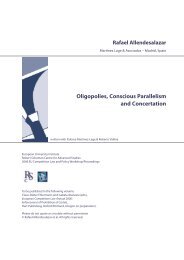Create successful ePaper yourself
Turn your PDF publications into a flip-book with our unique Google optimized e-Paper software.
48 bestprofileWork on sodium‐ion technologyprogressed sufficiently well tosecure three UK government grants:an initial £100,000($160841.5)from the Technology StrategyBoard (TSB) to produce ademonstrator, which led to afurther TSB demonstrator grantof £479,000. Faradion has alsosecured from the UK Departmentof Energy and Climate Change a£396,000 grant for a collaborativeproject with Sharp Laboratories todevelop and scale up a ‘new’ largeformat battery for residential andcommunity energy storage systems.With help from FinanceYorkshire, this money has beenused to move out of the Universityof Sheffield and establish its ownprototype sodium‐ion batteryline in rented facilities at itsheadquarters at the SheffieldInnovation Centre, within a stone’sthrow from its former base at theUniversity.The prototype line is end‐to‐end,including cathode making, coating,electrode punching, cell building,electrolyte fill, degas, testing, thewhole caboodle. Faradion is nowat a stage of making cells andpacks for deployment in trials,with the ultimate intention oflicensing the technology to batterymanufacturers.But, first things first, whysodium? “When we started, thesodium‐ion intellectual propertyfield was very, very sparse andthere were very few patentscompared to lithium,” says Wright.“We saw an opportunity for afleet‐of‐foot company like ourselvesto command a great deal ofintellectual property.“One of our first missions was tosynthesise very large numbers ofsodium‐ion materials ‐ we’ve sincelooked at over 2,000 ‐ and we’veso far identified 14 ‘patent families’covering thousands of materials.”Once Faradion started lookinginto sodium, it quickly realisednot only sodium carbonate for thecathode is cheaper than lithiumcarbonate, but also sodiumelectrolyte is less expensive thanlithium electrolyte and sodium saltsare more soluble than lithium salts,requiring a lower concentrationfor the same conductivity. And,whereas in a lithium cell youhave to use one copper currentcollector and one aluminiumcurrent collector, in a sodium cellyou can use two aluminium currentcollectors, says Wright.“Sodium‐ion does everythinglithium‐ion does, but cheaper,” hesays. “If a manufacturer alreadyhas a lithium‐ion plant, there is noincremental capital cost becauseit uses the same equipment.According to Argonne NationalLab’s BatPaC data model, a 16kWhsodium‐ion pack is 30% cheaper.”Characteristics of sodium‐ionOf course, as the ionic radius ofsodium is 30% greater than lithium,graphite cannot be used at theanode because its interlayer spaceis too narrow; it simply does not goin. The obvious alternative is hardcarbon.Hard carbons have a wideinterlayer space. As the interlayerspace is slightly disordered, theaverage space between the carbonlayers is wider than of graphite,allowing sodium ions to beinserted, explains chief technologyofficer Jerry Barker.“If you heat most carbonshigh enough they will crystalliseinto graphite,” he says. “Hardcarbons, on the other hard, can beturbostratically disordered, whichmeans the layers are rigidly heldapart rather than ‘graphitize’ nomatter how high the temperature.”While hard carbons arecommercially available, they tendto be optimised for lithium‐ion.Although they work perfectly wellfor sodium‐ion cells, Faradionmakes its own grades, which Barkerclaims outperform commercialgrades.To create suitable hardcarbons, Faradion dewaters thecarbohydrate source, be it sugar orcoconut shell or another suitablesubstance, leaving a precursorof a pre‐carbon to be heated ina particular range and particularatmosphere. The desired result isfor Faradion to optimise its ownhard carbons to be in a positionwhere a third party would be ableto pick it up and run with thetechnology.Sodium‐ion vs lithium‐ionenergy densityWhile sodium is a heavier metalthan lithium, it does not makea huge difference between asodium‐ion and lithium‐ion battery,says Barker.“Take lithium cobalt oxide,” hebestmagazine // Autumn 2014



